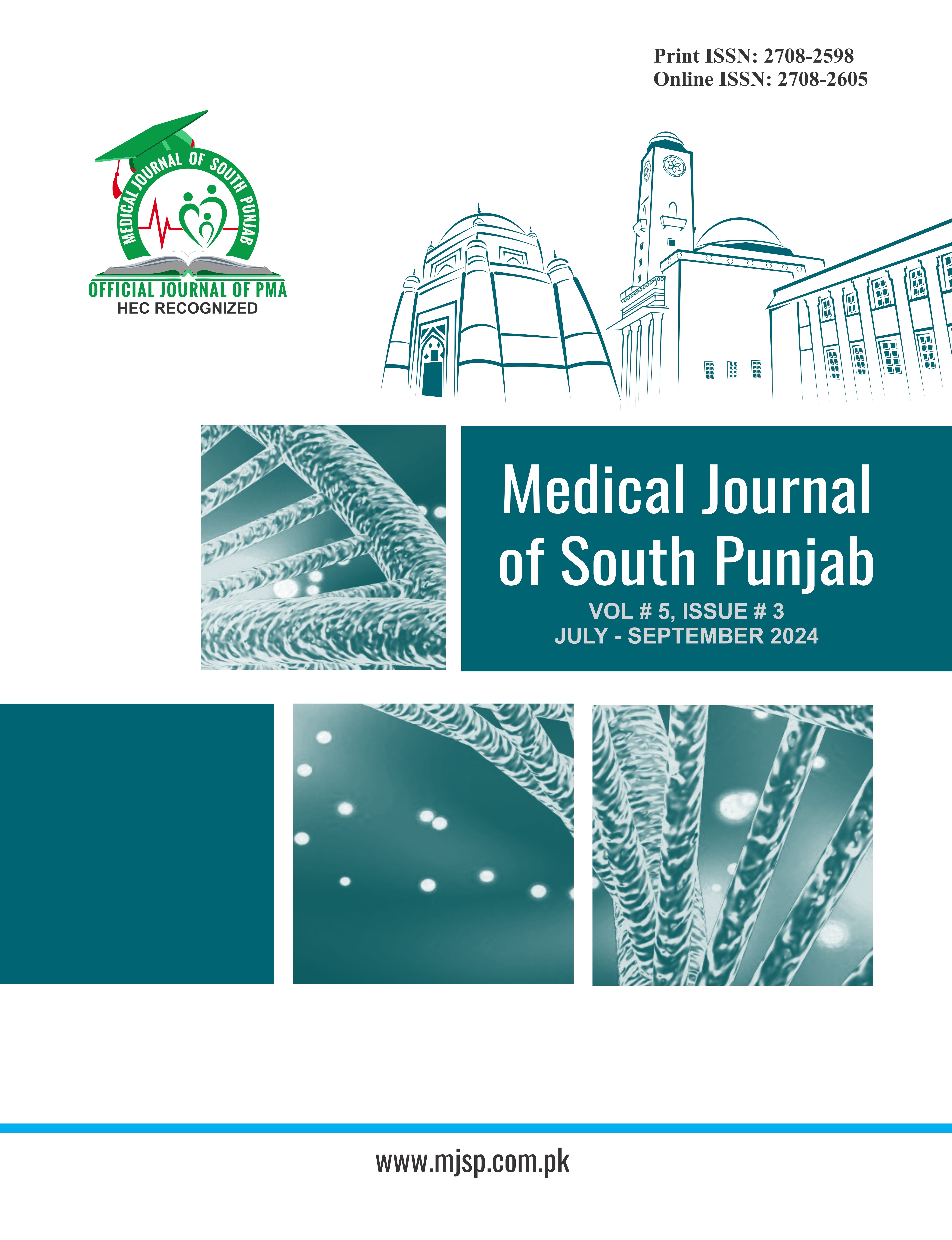Incidence of common nerve injuries in patients with oral and maxillofacial trauma present at tertiary care hospital
DOI:
https://doi.org/10.61581/mjsp.v5i03.360Keywords:
Incidence, Nerve inury, Oral, Maxillofacial trauma, Tertiary CareAbstract
Objective: To determine the frequency of common nerve injuries among patients presented with maxillofacial trauma.
Methodology: The study was designed as a cross-sectional study and conductedin the Department of Oral and Maxillofacial Surgery at Jinnah Postgraduate Medical Centre, Karachi, from November 2023 to May 2024. A detailed history was obtained from each patient, followed by a clinical examination to identify any nerve involvement due to maxillofacial trauma. Radiological evaluation in the form of Orthopantomogram (OPG) and Paranasal Sinus (PNS) views was carried out to assess the presence of fractures and any associated nerve injuries. The type of nerve injury was confirmed through a comprehensive clinical assessment and history to detect involvement of the olfactory, infraorbital, inferior alveolar, and facial nerves.
Results: Mean age was 32.4 ± 11.7 years. The majority of patients were male (70.0%), with females comprising 30.0% of the study population. In terms of type of nerve injury, the inferior dental nerve (IDN) was most commonly affected (44.6%), followed by the infraorbital nerve (ION) (28.5%), the facial nerve (18.5%), and the olfactory nerve (8.5%).
Conclusion: This study's findings align with global trends in oral and maxillofacial nerve injuries, showing male predominance and high RTA-related trauma incidence, though assaults are more common in developed nations, reinforcing known trauma-nerve injury associations.
Downloads
References
1. Wusiman P, Maimaitituerxun B, Saimaiti A, Moming A. Epidemiology and pattern of oral and maxillofacial trauma. J Craniofac Surg. 2020 Jul 1;31(5):e517-20.
2. Khan TU, Rahat S, Khan ZA, Shahid L, Banouri SS, Muhammad N. Etiology and pattern of maxillofacial trauma. Plos One. 2022 Sep 29;17(9):e0275515.
3. Tayyab TF, Khan AW, Geelani SR, Akram MA, Anwar A, Jan ZA. Incidence of peripheral nerve injury incidence among patients suffering from oral and maxillofacial trauma. Pak J Med Health Sci. 2022 May 1;16(03):1001.
4. Markiewicz MR, Callahan N, Miloro M. Management of traumatic trigeminal and facial nerve injuries. Oral Maxillofac Surg Clin. 2021 Aug 1;33(3):381-405.
5. Goh EZ, Beech N, Johnson NR. Traumatic maxillofacial and brain injuries: a systematic review. IntJ Oral Maxillofac Surg. 2021 Aug 1;50(8):1027-33.
6. Chalya PL, Mchembe M, Mabula JB, Kanumba ES, Gilyoma JM. Etiological spectrum, injury characteristics and treatment outcome of maxillofacial injuries in a Tanzanian teaching hospital. J Trauma Manag Outcom. 2011 Jun 2;5(1):7.
7. Altay S, Payza U, Erdoğan N, Uluç M. Frequency of maxillofacial injuries and accompanying types of maxillofacial fractures. Acıbadem Üniversitesi Sağlık Bilimleri Dergisi. 2021 Sep 29;12(4):720-4.
8. Petersen LØ, Ipsen EØ, Felding UA, von Buchwald C, Steinmetz J. Sequelae of major trauma patients with maxillofacial fractures. AnnOtol Rhinol Laryngol. 2021 May;130(5):475-82.
9. Agrawal A, Chandel S, Singh N, Singhal A, Yadav A. Maxillofacial fracture patterns in North Indian urban population. J Dent Scienc Res. 2013;4(1):1-4.
10. Khattak JU, Bibi M, Zamir A, Rehman Y, Anwar S. Frequency and pattern of infraorbital nerve dysfunction in patients with zygomaticomaxillary complex (ZMC) fractures. J Khyber Coll Dent. 2022 Mar 31;12(1):71-4.
11. Halim M, Khattak YR, Khan A. Common nerve injuries in oral and maxillofacial trauma: a cross-sectional study at Khyber College of Dentistry Peshawar. J Khyber Coll Dent. 2018 Jun 30;8(02):7-11.
12. Al-Khateeb T, Abdullah FM. Craniomaxillofacial injuries in the United Arab Emirates: a retrospective study. J Oral Maxillofac Surg. 2007;65(6):1094-1101.
13. Gassner R, Tuli T, Hächl O, Moreira R, Ulmer H. Craniomaxillofacial trauma: a 10-year review of 9,543 cases with 21,067 injuries. J Craniomaxillofac Surg. 2003;31(1):51-61.
14. Montovani JC, Campos LM, Gomes MA, Moraes VR, Ferreira FD, Nogueira EA. Etiology and incidence facial fractures in children and adults (in Portuguese). Rev Bras Otorrinolaringol. 2006; 72:235-41.
15. Al Ahmed HE, Jaber MA, Abu Fanas SH, Karas M. The pattern of maxillofacial fractures in Sharjah, United Arab Emirates: a review of 230 cases. Oral Surg Oral Med Oral Pathol Oral RadiolEndod. 2004; 98(2):166-70.
16. Boffano P, Kommers SC, Karagozoglu KH, Forouzanfar T. Aetiology of maxillofacial trauma: a review of published studies. Int J Oral Maxillofac Surg. 2015;44(11):1400-1411.
17. Lee KH, Snape L, Steenberg LJ, Worthington J. Comparison of interpersonal violence and motor vehicle accidents on the incidence of facial trauma. J Oral Maxillofac Surg. 2017;75(4):796-802.
18. Ziccardi VB, Zuniga JR. Nerve injuries after third molar removal. Oral Maxillofac Surg Clin North Am. 2007 Feb;19(1):105-15.
19. Poort LJ, van Neck JW, van der Wal KG. Sensory testing of inferior alveolar nerve injuries: a review of methods used in prospective studies. J Oral Maxillofac Surg. 2009;67(2):292-300.
20. Brajdić D, Virag M, Uglešić V, Aljinović-Ratković N, Zajc I, Macan D. Evaluation of the sensitivity of teeth after mandibular fractures. Int J Oral Maxillofac Surg. 2011;40(3):266-70.
21. Rehman A, Noreen R, Ahmad T, Shah SMA, Din Q. Inferior alveolar nerve injury in mandibular angle fractures- A study. J KCD 2013;4(1):16-9.
22. Klenk G, Kovacs A. Etiology and patterns of facial fractures in the United Arab Emirates. J Craniofac Surg. 2003; 14:78-84.
Downloads
Published
Issue
Section
License
Copyright (c) 2024 Sarfraz Ali, Jehan Alam, Ruqayah Shah, Ahmad Sohail

This work is licensed under a Creative Commons Attribution 4.0 International License.
Authors retain copyright and grant the journal right of first publication with the work simultaneously licensed under a Creative Commons Attribution (CC-BY) 4.0 License that allows others to share the work with an acknowledgment of the work’s authorship and initial publication in this journal.







